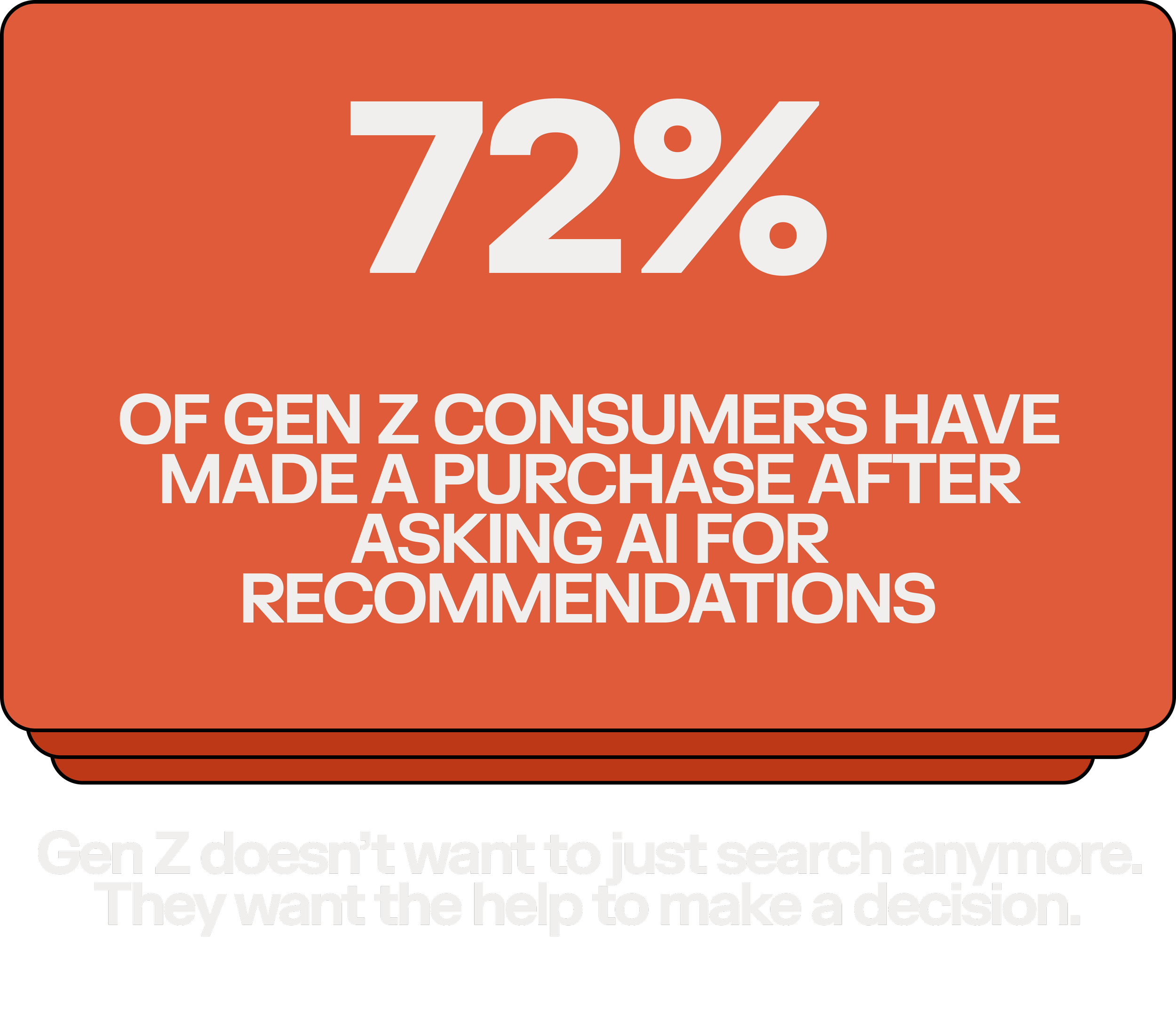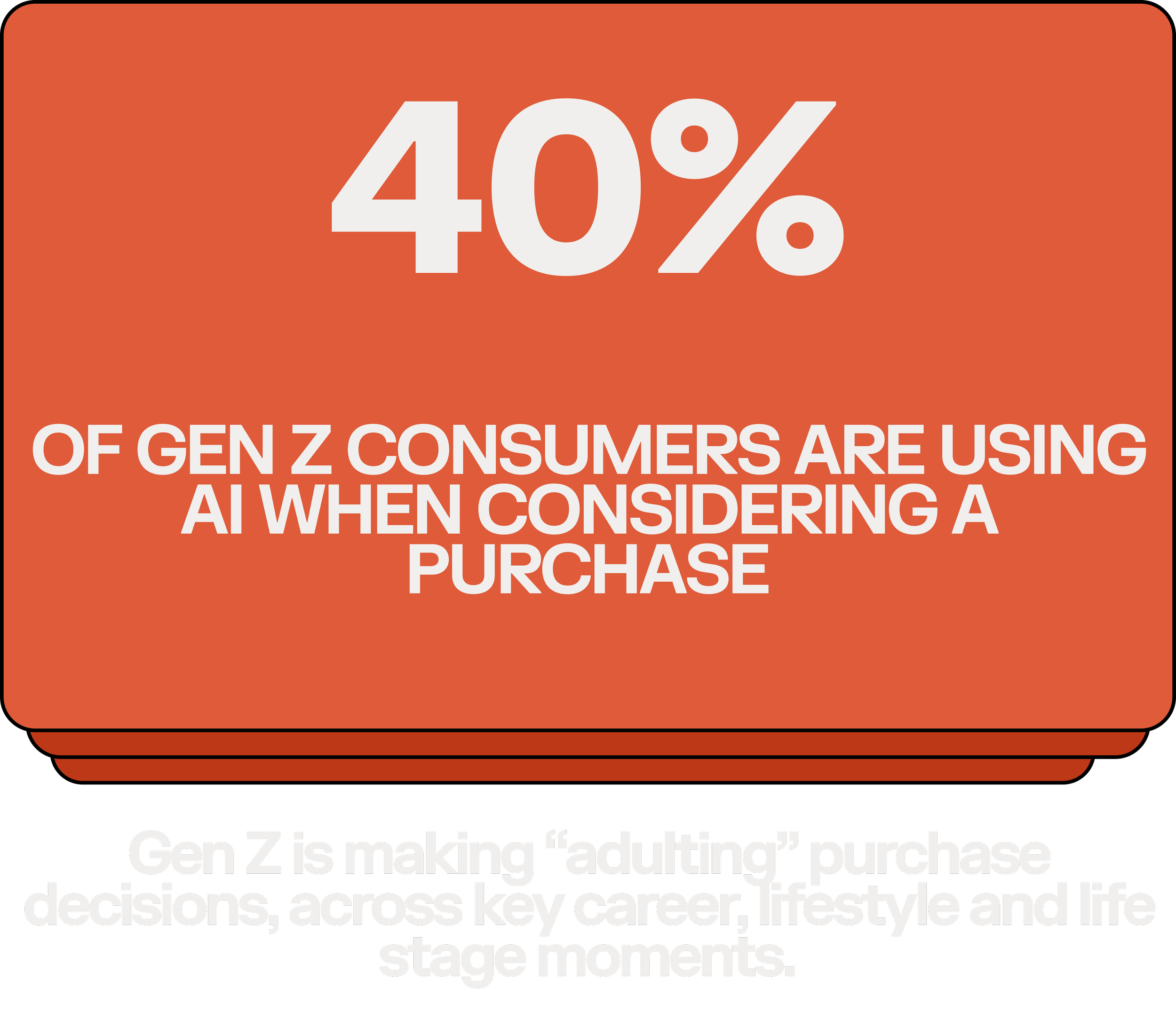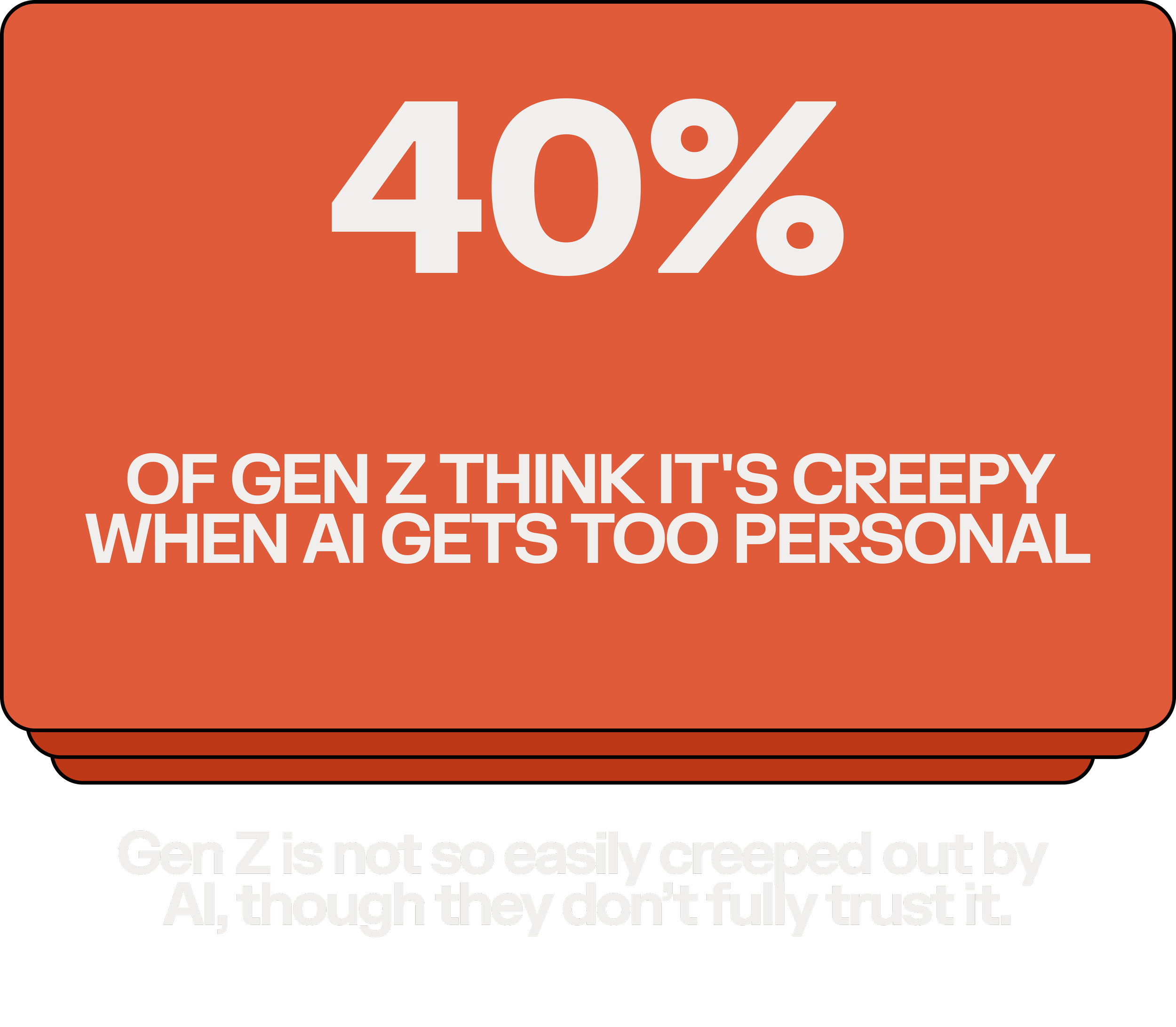From the way they search, the way they shop, the way they make decisions - Gen Z is using AI to make it work for them.
Yet the majority of brands are investing into standard marketing and marketplace channels, not knowing that much of the finding and decisioning is based on a fast-changing journey.
Brands need to brace for change. In just 2 short years, Gen Z will be between the ages of 18-30. And if they want to meet these high-stake consumers on their omni-channel, AI-assisted path, brands need to start moving quickly.
Here's 5 things to know right now:
With AI, search intent has fundamentally moved from exploration and discovery to consideration and decision. As the most informed generation, Gen Z wants information - pricing, reviews, ratings, etc. - before making purchase decisions. Once a fragmented journey across online/offline destinations, AI is collapsing the research process, helping Gen Z to make decisions, faster.
Gen Z consumers are doing more research and buying faster through AI, often in the same session. At a consumer’s most important decision moments, AI is beating traditional search 21% to 12% for narrowing options and 15% to 12% at purchase. And when they use AI to research, they act: 61% purchase within the same day.
As the cohort with the highest usage of daily AI, 2 out of 3 older Gen Zs are using AI to make day-to-day decisions (fitness, food, entertainment), as well as big milestone decisions (finances, housing, career), and want the ease and time-savings that AI promises to bring. While still skeptical of accuracy and trustworthiness, they come back to AI for more and anticipate using it even more in the next year.
Various AI platforms and solutions have been pressed with understanding the threshold for creepiness that comes intrinsically with AI. Gen Z is quickly becoming AI-savvy: confident at spotting AI-generated content, using it beyond search and creatively using AI to make their lives easier. While AI’s authority might get better with personalization, Gen Z will only tolerate it if it’s out-weighed by helpfulness.
When Gen Z prompts AI for “best for me” recommendations, they do not care about the familiarity of results as they do about the relevance of the results. Via AI, brand perceptions – reviews, commentary, mentions – are working hard, either for or against brands. Legacy of data is up against fresh brand storytelling to influence AI recommendations.
What did we learn?
Who are the new AI natives?
Gen Z AI users are even savvier than you think they are, and they are first mastering AI at work and bringing that home – creating the most valuable consumer audience with both the skills and spending power.
Our study reveals a surprising truth about AI adoption: Gen Z of working age – the heaviest users of AI – are bringing home the AI skills they’re likely using at the office. They represent a perfect storm: sophistication and savviness to use AI and the paychecks to act on it. Brands focusing on traditional marketing channels are missing the real opportunity sitting in office towers.
Is AI rewiring the purchase journey?
AI is accelerating the path to purchase and driving conversion at rates outside of traditional consideration phases. And that’s because AI is enabling even more hyper-informed decisions at unprecedented speed – not only are consumers researching more intensely, they’re buying faster, too. It’s setting new expectations for intelligent assistance – and opening new opportunities for brands.
The paradox of modern shopping: compared to last year, consumers are doing 41% more research while buying 61% faster — often within the same session. AI doesn't skip the consideration phase; it compresses weeks into minutes. When 64% of users need only 0-2 follow-up questions before purchasing, we're witnessing a purchase funnel requiring more product intel from brands and a revisiting of traditional marketing messages that are no longer sufficient. Consumers have a greater need for information, resulting in greater confidence and higher conversion.
Which categories are missing their window of opportunity?
Not all categories are created equal. Clear preferences are emerging as AI embeds itself in daily routines. While Food and Cooking still dominate at half of all usage, consumers are moving on to Entertainment, Gaming, Apparel and Accessories – signaling AI's move from novelty to necessity.
Our study reveals that “what’s for dinner” is an entry point for AI adoption, conquering daily micro-decisions before moving onto major purchases. The consumer’s hierarchy is telling: frequent, often rote decisions (meals) to personal expression (fashion) and more considered purchases (electronics) demonstrates the way consumers expand their comfort zones – building familiarity before commitment. Brands reliant on discretionary spend could be losing out to almost two-thirds of their addressable market in consideration, while those serving consumer necessities – banking, medical services, health/wellness – have greater potential to show up for unmet needs.
Can ‘personalization’ ever feel too personal?
Our study reveals a surprising truth about AI adoption: Gen Z of working age – the heaviest users of AI – are bringing home the AI skills they’re likely using at the office. They represent a perfect storm: sophistication and savviness to use AI and the paychecks to act on it. Brands focusing on traditional marketing channels are missing the real opportunity sitting in office towers.
Is AI changing how Gen Z search?
Our study reveals a surprising truth about AI adoption: Gen Z of working age – the heaviest users of AI – are bringing home the AI skills they’re likely using at the office. They represent a perfect storm: sophistication and savviness to use AI and the paychecks to act on it. Brands focusing on traditional marketing channels are missing the real opportunity sitting in office towers.
What did Gen Z have to say?
In addition to our quantitative study of 500 consumers, we interviewed Gen Z consumers across the U.S. to get their take on AI.
The one word that came up time and time again? Helpful.
Where do you go first when you have a question?
If I have a question about something and I need an answer, I'll just ask ChatGPT — and that's because I also have my browser set to it.
16, HIGH SCHOOL STUDENT, LOS ANGELES
How would you describe what AI 'does'?
I would use the word expand. For gaming, when I have an idea I use it to grow from a starting point. I pick and choose what I want to continue with while chatting with it, and it allows me to build upon my world.
27, PAINTER, CHICAGO
Why are Gen Z consumers so keen on finding, instead of searching?
It was more helpful overall. I bought maybe a dress or two from that search. It's similar to doing a Google search, but I thought about it - it's just easier if it lists it all out for me, rather than scrolling through the Google results that come up.
25, NURSE, PITTSBURGH
How has AI changed the way Gen Z seek information?
I just slowly started using it more and preferring it more because of the way it was responding to me... I still use Google for things like definitions. But if I have a specific question, it's easier to just go to ChatGPT.
19, COLLEGE STUDENT, PHILADELPHIA
What role does brand play in how Gen Z consumers engage with AI?
I often include in my prompts things like 'give me a well-reviewed one' or 'above 4.6 stars with at least 3,000-4,000 reviews,' so I know the product is trustworthy... When I want to find more niche things, I narrow my search and say 'just find me anything.'
21, COLLEGE STUDENT, LOS ANGELES
Where does Gen Z draw the line with AI? When does it get weird?
I have friends who'll text it and ask for advice, or relationship advice, basically treat it as a therapist. I feel like that's just crossing the line to me... I'm worried that that's where we're headed, where we just rely on AI for life advice... When you get to the point where you're replacing actual people, that's when it's weird to me.
19, COLLEGE STUDENT, NEW YORK CITY

So now what?
What do brands need to do, right now, in order to win with their Gen Z consumers in an AI-assisted world?
Know your target consumers.
If you’re a brand that wants to be for everyone, we fear that you’ll end up being for no one in particular when it comes through AI. As the perceived helpfulness of AI improves with accurate personalization, brands need to be able to express who they are for, and why. If you don’t have target consumer segmentation or haven’t refreshed it in a few years, AI is your trigger to get that going.
Know their consumer journey.
With the infinite loop of social media mixed with the fast work of AI towards the bottom of the funnel, how do you want your brand to show up on your target consumer’s journey, on their path to purchase? Understanding key moments that matter, the data and content needed to find them on their journey, and the orchestration needed across all channels for a full omni-channel strategy will be critical to know how best to meet them, both IRL and URL.
Get really good at brand storytelling.
Your brand story is being told, but most importantly by what people say about you in digital formats. Volume and frequency of mentions work in social media to build brand awareness. And brand perceptions move when consistency creates convictions, stemming from authentic brand storytelling across all channels. But changing perceptions in AI-led research is going to be hard. Brands need fresh and evergreen content, along with earned and owned media to help tell your brand and product stories. Influencers, forums, reviews, ratings feed the data-rich needs to make brands relevant and breakthrough in AI. And by the way, winning with AI will also make the storytelling on all of your channels that much better too.
Make your consumer touchpoints count.
Even with Gen Z’s growing use of AI, Gen Z does not want it to be a complete replacement for the tactical and physical engagement that comes with shopping and experiences. Gen Z loves the fun and thrill of shopping. Gen Z craves community and in-person experiences. But they’ll naturally expect the in-person experiences to be even more helpful and enriching than AI, with the tangible benefits that AI could never. Creating enticing spaces, welcoming community with available and helpful associates, and offering memorable, multi-sensory experiences will increasingly become a key way to directly engage and win with your target consumers. If they come into your space and feel like AI could have done better, than you need to do better, much better.










